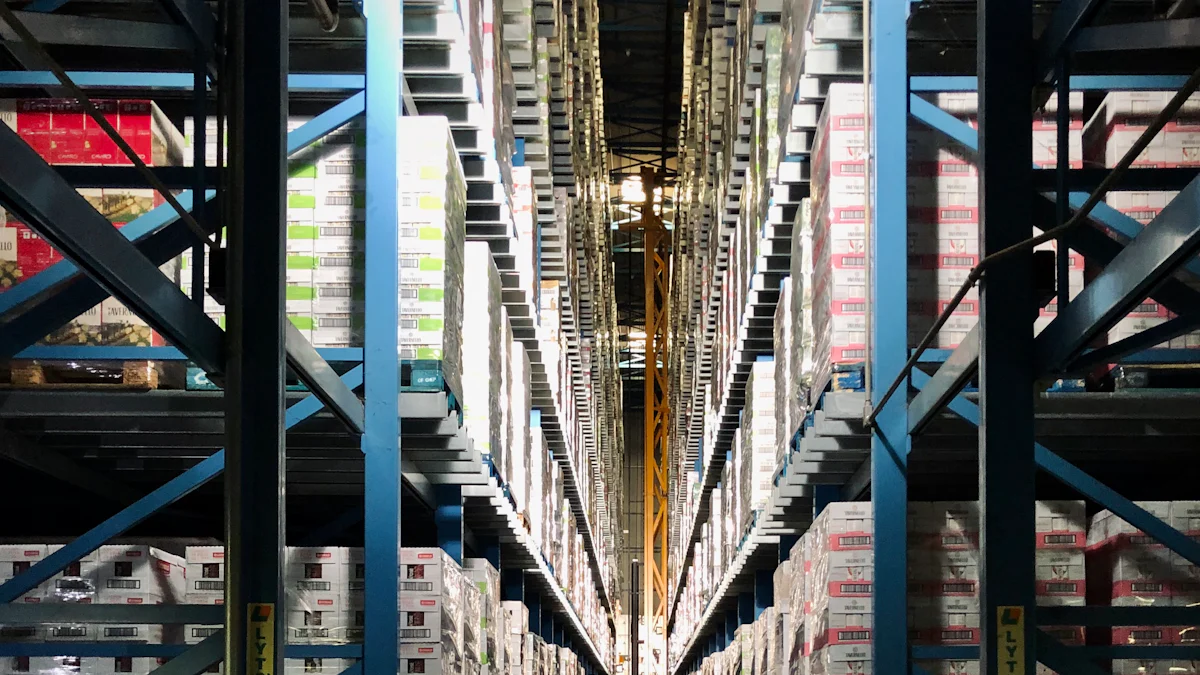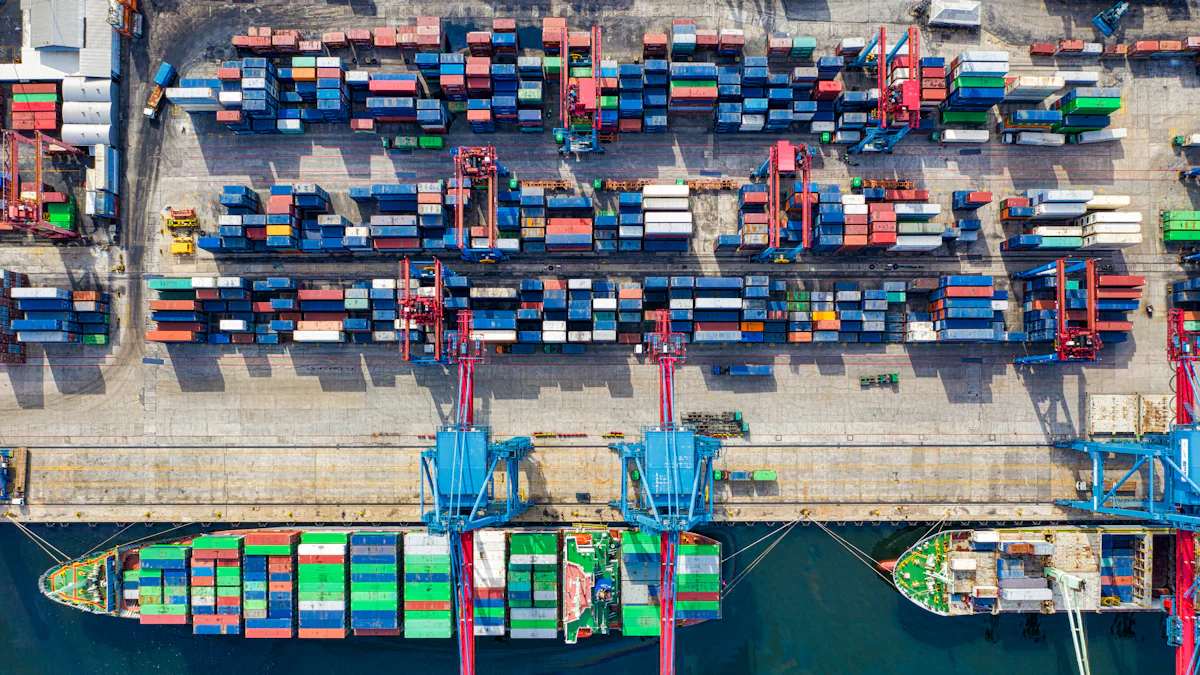Optimizing Solutions for High-Tech Manufacturing's Supply Chain Issues

In high-tech manufacturing, supply chain issues can significantly impact operational efficiency and profitability. Companies striving for success must also prepare for future supply chain issues that may arise from ongoing disruptions and risks. Common challenges such as data overload, integration issues, and component shortages hinder seamless operations. To address these hurdles effectively, innovative solutions are crucial. This blog delves into strategies that leverage advanced analytics, AI, and machine learning to streamline processes and enhance overall performance.
Understanding the Supply Chain Crisis

What’s behind the global supply chain crisis?
The global supply chain crisis is a multifaceted issue, driven by a confluence of global events that have severely disrupted supply chains worldwide. At the heart of this crisis are several key factors, including the ongoing Russia-Ukraine conflict, COVID-19 lockdowns in China, and escalating fuel and energy costs. These events have created a ripple effect, leading to significant delays, increased costs, and reduced product availability across various industries.
The Russia-Ukraine conflict has particularly impacted the supply of critical materials such as industrial metals and minerals, essential for high-tech manufacturing. Meanwhile, COVID-19 lockdowns in China, a major hub for global manufacturing, have caused substantial production slowdowns and shipping delays. Additionally, the surge in fuel and energy prices has further strained transportation and logistics, compounding the challenges faced by global supply chains.
This crisis has also exposed underlying vulnerabilities within global supply chains, such as an over-reliance on single suppliers, lack of diversification, and inadequate risk management practices. These weaknesses have highlighted the need for more robust and resilient supply chain strategies to navigate the complexities of the current global landscape.
Identifying Supply Chain Disruptions
When examining the supply chain issues in high-tech manufacturing, one prominent challenge is Data Overload. The excessive influx of data from various sources can overwhelm systems, leading to inefficiencies and operational bottlenecks. This issue arises due to the continuous monitoring of production processes, resulting in a flood of information that is challenging to manage effectively.
In addition to Data Overload, high-tech manufacturers also face Integration Challenges. These stem from the diverse sources of data within the supply chain that need to be harmonized for seamless operations. The lack of standardized integration protocols often leads to miscommunication between systems, impacting overall efficiency and coordination.
Furthermore, Component Shortages pose a significant risk to production continuity in high-tech manufacturing. The scarcity of critical components can disrupt the entire manufacturing process, causing delays and potentially affecting product quality. Understanding the root causes behind these shortages is crucial for implementing proactive measures to mitigate their impact on operations.
Addressing these supply chain issues requires a comprehensive approach that combines technological solutions with a robust supply chain strategy. By leveraging advanced analytics, companies can gain valuable insights into their data streams, enabling informed decision-making and predictive maintenance strategies. Implementing AI and machine learning algorithms further enhances operational efficiency by automating repetitive tasks and optimizing resource allocation.
To overcome integration challenges, standardizing data formats across different systems is essential for establishing clear communication channels and ensuring data accuracy. Embracing IoT technologies and Industry 4.0 principles facilitates real-time data exchange and connectivity between devices, fostering a more interconnected supply chain ecosystem.
Causes of Supply Chain Disruption

The Impact of Global Events on Supply Chains
Global events, ranging from natural disasters to geopolitical conflicts, can have profound and far-reaching impacts on supply chains. The Russia-Ukraine conflict, for instance, has disrupted the supply of essential materials, including metals and minerals critical for high-tech manufacturing. This disruption has led to shortages and increased costs for manufacturers reliant on these materials.
Similarly, the COVID-19 lockdowns in China have had a significant impact on the production and shipping of goods. As one of the world’s largest manufacturing hubs, China’s lockdowns have caused delays in production schedules and shipping timelines, affecting global supply chains. The ripple effects of these disruptions are felt across various industries, leading to delays, increased costs, and reduced product availability.
Moreover, rising fuel and energy costs have exacerbated supply chain disruptions by increasing transportation and logistics expenses. These additional costs are often passed down the supply chain, resulting in higher prices for end consumers.
To mitigate the risks posed by such global events, companies must develop resilient supply chain strategies. This involves anticipating potential disruptions and implementing measures to minimize their impact. By building resilient supply chains, companies can better navigate the uncertainties of the global market and maintain operational continuity.
Solutions for Data Overload
Implementing Advanced Analytics
In addressing the challenge of Data Overload in high-tech manufacturing supply chains, companies are increasingly turning to Advanced Analytics to extract valuable insights from the vast amounts of data generated. By implementing sophisticated analytical tools and techniques, organizations can effectively process and analyze complex datasets to drive informed decision-making and enhance operational efficiency.
Benefits of Analytics
Leveraging advanced analytics offers a multitude of benefits for high-tech manufacturers. Companies can gain real-time visibility into their supply chain processes, enabling proactive identification of potential bottlenecks or disruptions. This proactive approach helps optimize inventory management, reduce lead times, and improve overall production planning.
Advanced analytics also empower organizations to forecast demand more accurately, leading to optimized resource allocation and improved customer satisfaction. By leveraging predictive analytics models, companies can anticipate market trends and customer preferences, enabling them to tailor their offerings accordingly.
Furthermore, by harnessing the power of prescriptive analytics, businesses can optimize their decision-making processes by simulating various scenarios and evaluating the potential outcomes. This strategic approach allows companies to mitigate risks effectively and capitalize on emerging opportunities in the dynamic high-tech manufacturing landscape.
Case Studies
Implementing advanced analytics in supply chain management has revolutionized how high-tech manufacturers operate. By analyzing vast datasets in real-time, companies have been able to streamline their operations and enhance overall efficiency.
italic "The integration of advanced analytics has enabled us to proactively address supply chain disruptions and optimize our production processes," said a leading high-tech manufacturer.*
Through the application of predictive analytics models, organizations have significantly improved their demand forecasting accuracy, resulting in reduced inventory costs and enhanced customer satisfaction.
italic "By leveraging advanced analytics tools, we have been able to anticipate market trends with greater precision and align our production strategies accordingly," shared a prominent industry expert.*
Utilizing AI and Machine Learning
Another pivotal solution for mitigating Data Overload challenges is the strategic utilization of AI (Artificial Intelligence) and Machine Learning technologies within high-tech manufacturing supply chains. These cutting-edge technologies empower companies to automate repetitive tasks, uncover hidden patterns within data streams, and drive continuous process improvements.
AI Applications in Supply Chain
The integration of AI applications in supply chain management enables high-tech manufacturers to enhance operational efficiency through intelligent automation. AI-powered algorithms can analyze vast datasets at unparalleled speeds, allowing organizations to make data-driven decisions swiftly.
AI-driven predictive maintenance solutions enable proactive equipment monitoring by predicting potential failures before they occur. This preventative approach minimizes downtime, reduces maintenance costs, and extends the lifespan of critical machinery.
Moreover, AI-enhanced demand forecasting algorithms provide high-tech manufacturers with accurate insights into future market demands. By leveraging machine learning models that adapt to changing consumer behaviors, companies can optimize their production schedules and inventory levels accordingly.
Success Stories
Machine Learning in Supply Chain Case Study
A notable case study showcasing the successful application of machine learning in supply chain management involved a leading high-tech manufacturer optimizing its logistics operations through data-driven insights.
italic "By utilizing machine learning algorithms to analyze our logistics data, we were able to identify inefficiencies in our transportation routes and streamline our delivery processes," stated a logistics manager at the company.*
The implementation of machine learning algorithms enabled the organization to reduce transportation costs significantly while improving delivery timelines for customers across diverse geographical regions.
italic "Our experience with integrating machine learning into our supply chain operations has not only enhanced our operational efficiency but also strengthened our competitive edge in the market," emphasized a senior executive at the company.*
Enhancing Integration and Interoperability for Greater Supply Chain Visibility
Standardizing Data Formats
Standardizing data formats is crucial for ensuring seamless communication and interoperability within high-tech manufacturing supply chains. By establishing uniform protocols for data exchange, companies can overcome integration challenges and enhance operational efficiency. The importance of standardization lies in promoting consistency, accuracy, and reliability throughout the supply chain ecosystem.
Importance of Standardization
Consistency: Standardized data formats facilitate consistent information exchange between disparate systems, eliminating errors and discrepancies that may arise from incompatible data structures.
Interoperability: By adopting standardized formats, organizations can achieve seamless interoperability between various applications and devices, enabling smooth data flow across the entire supply chain network.
Efficiency: Standardization streamlines data processing tasks by providing a common language for encoding and decoding information. This efficiency translates into faster decision-making processes and improved response times to dynamic market demands.
Reliability: Ensuring that all stakeholders adhere to standardized data formats enhances the reliability of information exchanges, reducing the risk of misinterpretation or data corruption during transmission.
Implementing Strategies:
Establish Clear Guidelines: Define clear guidelines and protocols for data formatting to ensure consistency across all touchpoints in the supply chain.
Adopt Industry Standards: Embrace industry-standard formats such as EDI (Electronic Data Interchange) or XML (eXtensible Markup Language) to promote compatibility with external partners and systems.
Automate Data Mapping Processes: Utilize automated tools and software solutions to map data fields between different systems accurately, minimizing manual errors and improving overall data quality.
Regular Compliance Audits: Conduct regular audits to verify compliance with established data format standards and identify areas for improvement or optimization.
Leveraging IoT and Industry 4.0
The integration of Internet of Things (IoT) technologies and Industry 4.0 principles offers unparalleled opportunities for enhancing connectivity, visibility, and control within high-tech manufacturing supply chains. Leveraging IoT solutions enables real-time monitoring, predictive analytics, and process automation to drive operational excellence across diverse functions.
IoT Benefits
Real-Time Tracking: IoT devices enable real-time tracking of assets, inventory levels, and production processes, providing valuable insights into operational performance metrics.
Predictive Maintenance: By leveraging IoT sensors for predictive maintenance applications, companies can proactively identify equipment failures before they occur, minimizing downtime and optimizing maintenance schedules.
Data-driven Decision Making: IoT-generated data empowers organizations to make informed decisions based on actionable insights derived from continuous monitoring of key performance indicators.
Enhanced Supply Chain Visibility: IoT technologies enhance supply chain visibility by providing end-to-end traceability of products, enabling efficient inventory management and demand forecasting strategies.
Industry 4.0 Integration
Industry 4.0 integration involves the convergence of digital technologies with traditional manufacturing processes to create smart factories capable of autonomous operation and adaptive production systems. Key components of Industry 4.0 implementation include:
Smart Manufacturing: Implementing intelligent automation systems that leverage AI algorithms to optimize production workflows based on real-time demand signals.
Cyber-Physical Systems: Integrating physical machinery with digital controls to create interconnected systems that monitor performance metrics in real time.
Cloud Computing: Leveraging cloud-based platforms for storing and analyzing vast amounts of IoT-generated data to drive predictive analytics models.
Augmented Reality (AR): Deploying AR technologies in manufacturing operations for remote assistance, training simulations, and enhanced visualization capabilities.
To optimize supply chain management and ensure long-term success, continuous improvement is essential. This approach fosters a culture of learning, innovation, and data-driven decision-making.
Prioritizing the elimination of waste and actively involving employees in developing solutions to challenges are key aspects of creating a culture of continuous improvement within organizations.
Continuous improvement is not just a one-time effort but an ongoing commitment to enhancing processes and driving efficiency in high-tech manufacturing supply chains. Embracing this proactive and iterative approach will position companies for sustained growth and competitiveness in the dynamic market landscape.
Strategies for Supply Chain Resilience
Building Resilience in Supply Chains
Building resilience in supply chains is essential for companies to withstand disruptions and maintain a competitive edge. A multi-faceted approach is required, involving the diversification of suppliers, investment in supply chain data and analytics, and the development of flexible and adaptable supply chain networks.
One effective strategy is dual sourcing, where companies source critical components from multiple suppliers. This reduces the risk of supply chain disruptions caused by over-reliance on a single supplier. Nearshoring, or sourcing from geographically closer suppliers, can also enhance supply chain resilience by reducing transportation times and costs.
Investing in supply chain data and analytics is another crucial aspect of building resilience. By leveraging advanced analytics, companies can gain greater supply chain visibility, enabling them to anticipate and respond to disruptions more effectively. Real-time data insights can help optimize inventory management, improve demand forecasting, and enhance overall supply chain planning.
Developing flexible and adaptable supply chain networks is also vital. This involves creating supply chain strategies that can quickly adjust to changing market conditions and disruptions. Just-in-time inventory management, for example, allows companies to reduce excess inventory and respond more swiftly to changes in consumer demand.
By implementing these strategies, companies can build resilient supply chains that are better equipped to handle disruptions, improve customer satisfaction, and maintain a competitive advantage in the market.
